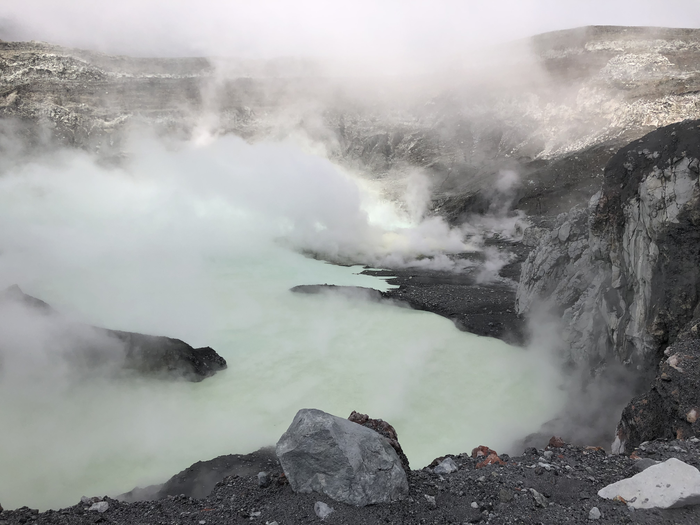Bacteria living in ultra-acidic, boiling volcanic lake show how life might have existed on Mars
Bacteria living in extreme conditions had special ways to create energy using sulphur, iron and arsenic

Your support helps us to tell the story
From reproductive rights to climate change to Big Tech, The Independent is on the ground when the story is developing. Whether it's investigating the financials of Elon Musk's pro-Trump PAC or producing our latest documentary, 'The A Word', which shines a light on the American women fighting for reproductive rights, we know how important it is to parse out the facts from the messaging.
At such a critical moment in US history, we need reporters on the ground. Your donation allows us to keep sending journalists to speak to both sides of the story.
The Independent is trusted by Americans across the entire political spectrum. And unlike many other quality news outlets, we choose not to lock Americans out of our reporting and analysis with paywalls. We believe quality journalism should be available to everyone, paid for by those who can afford it.
Your support makes all the difference.Scientists have discovered how some extreme microbes with special adaptations survive in the ultra-acidic, boiling crater lake of the active Poás Volcano, an advance that sheds more light on if and how life might have existed on Mars.
The research, published in the journal Frontiers in Astronomy and Space Science on Friday, assessed bacteria living in the hydrothermal crater lake of the Poás volcano in Costa Rica – one of the most hostile habitats on the planet.
Water in this lake is ultra-acidic, full of toxic metals, varies in temperature from comfortable to boiling, and undergoes recurrent explosive eruptions of steam, ash and rock, the researchers from National University of Costa Rica and the University of Colorado, Boulder in the US said.
If the Red Planet ever had hosted life, scientists say it may have been in such extreme hydrothermal environments with deadly eruptions – which are thought to be places where life may have originated even on Earth.
“One of our key findings is that, within this extreme volcanic lake, we detected only a few types of microorganisms, yet a potential multitude of ways for them to survive,” Justin Wang, study co-author and a graduate student at the University of Colorado Boulder, said in a statement.
“We believe they do this by surviving on the fringes of the lake when eruptions are occurring. This is when having a relatively wide array of genes would be useful,” Mr Wang added.
In 2013, researchers had found that there was just one microbial species in the Poás volcanic lake from the genus Acidiphilium – a type of bacteria commonly found in acid mine drainages and hydrothermal systems.
These bacteria are known to have multiple genes adapted to diverse surroundings.
The new research, following a series of eruptions, showed that there was a bit more diversity of microbial species in the lake, but Acidiphilium bacteria still dominated.
Analysis of samples of lake fluid, sulphur clumps, and lake bottom sediment using cutting-edge genome sequencing technology have revealed that the lake hosts an extremely low biodiversity of microorganisms dominated by Acidiphilium species.
Genome sequencing work revealed that the bacteria have a wide variety of biochemical capabilities to potentially help them tolerate extreme and dynamic conditions, such as pathways to create energy using sulphur, iron, and arsenic.
They also possess genes linked to carbon fixation, as seen in plants – for both simple and complex sugars and bioplastic granules – which the microbes use as energy and carbon reserves during stress or starvation.
“We expected a lot of the genes that we found, but we didn’t expect this many given the lake’s low biodiversity,” Mr Wang said.
“This was quite a surprise, but it is absolutely elegant. It makes sense that this is how life would adapt to living in an active volcanic crater lake,” he added.
Although hydrothermal systems have extremely lethal surroundings, researchers say they provide most of the key ingredients for the evolution of life, including heat, water and energy and similar locations might have also harboured life on Mars.
“The perseverance of life in Laguna Caliente indicates life on Mars could have thrived in analogous environments, stressing the need for the search for life in relict Martian acid-sulphate hydrothermal systems,” the scientists wrote in the study.
While efforts to probe the Red Planet for ancient microbial life have so far majorly focused on stream beds or river deltas, the authors of the current study suggest that more attention should be given to the sites of past Martian hot springs.
“Our research provides a framework for how ‘Earth life’ could have existed in hydrothermal environments on Mars,” Mr Wang said.
“We hope that our research steers the conversation to prioritise searching for signs of life in these environments, for example there are some good targets on the crater rim of Jezero Crater, which is where the Perseverance rover is right now,” he added.
Join our commenting forum
Join thought-provoking conversations, follow other Independent readers and see their replies
Comments